“I took this course about organic chemical contaminants because I’m intrigued by the myriad chemicals present in our daily lives — in the water we drink, the air we breathe, even the food we consume,” says Jennifer Zhou. “I was keen to explore how they impact our bodies and overall health.”
Zhou is a member of Innis College double majoring in biochemistry and toxicology, and minoring in environmental chemistry. The course — Environmental fate and toxicity of organic contaminants (CHM3130H1) — is taught by Hui Peng, an assistant professor in the Faculty of Arts & Science’s Department of Chemistry.

The course focuses on the organic chemical contaminants that permeate our everyday lives and are found in medications, personal-care products, flame retardants, refrigerants, plastics, clothing, building materials and more. Students learn where organic chemicals end up — in the environment and in our bodies — and about the damage they can cause.
“The most important thing I’ve learned from the course has been the paths contaminants follow to accumulate in our bodies,” says Toshi Tall, a member of University College in a specialist chemistry program.
“Chemical compounds can travel great distances by air or water — some traveling as far as the Arctic,” he says. “Some mix with the fats in organisms and remain there indefinitely. The course has improved my understanding of how compounds enter and remain in our bodies and has taught me how to identify what kinds of molecules are more likely to do so.”
The students learned about the environmental dangers posed by various contaminants. One example is the organic chemical 6PPD, used in vehicle tires to extend their lifespan. When tiny particles of rubber are worn from tires, the 6PPD they contain reacts with ozone in the air to form toxic 6PPD quinone. The particles are then washed into streams, rivers and lakes where the compound poses a serious threat to the organisms living in those habitats.
I’m planning to complete a focus in green chemistry where you learn about sustainable chemistry and how chemicals can affect human health and the environment. This course helped me better appreciate the far-reaching consequences of the practice of chemistry and how to apply sustainability to my work in the future.
“This revelation fascinated me, as it shed light on the various pathways through which chemicals can inadvertently impact organisms, including salmon,” says Zhou. “And while it’s widely recognized that cars contribute to environmental pollution, this course illuminated how these pollutants can undergo chemical reactions to become even more hazardous to organisms.”
Students also learned how the structure of compounds relates to their toxicity. For example, highly toxic dioxins can cause cancer and other health problems and take a long time to break down. They are found in textiles, plastics and building materials and are emitted into the air in our homes which we then breathe in; we also consume them in the food we eat.
“So, we use this example to show students how important it is to understand the relationship between chemical structure and toxicity,” says Peng. “It is dioxin’s chemical structure that makes it so toxic and persistent — and therefore so harmful.”
The students learned that contaminants are harmful to organisms because of how they interact with proteins, thereby preventing them from functioning properly. For example, in certain species of fish, contaminants can interfere with the estrogen receptors in proteins. This can ultimately alter a fish’s organs, so much so that males can produce eggs.
Peng is hopeful that students will gain a better understanding of the workings and dangers of these chemical contaminants and thus make informed decisions about them in their future careers as organic chemists.
“I’m planning to complete a focus in green chemistry where you learn about sustainable chemistry and how chemicals can affect human health and the environment,” says Tall. “This course helped me better appreciate the far-reaching consequences of the practice of chemistry and how to apply sustainability to my work in the future.”

